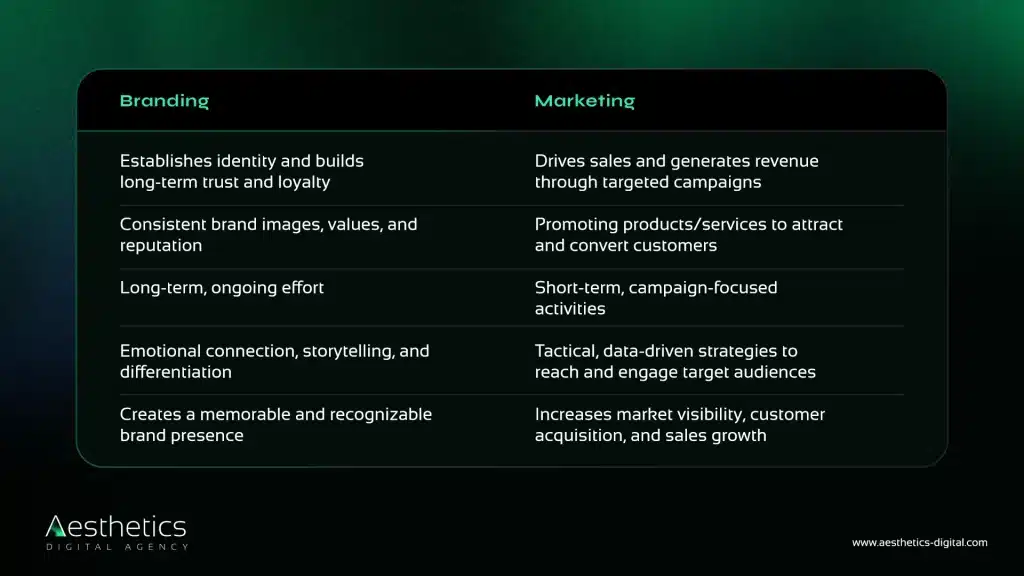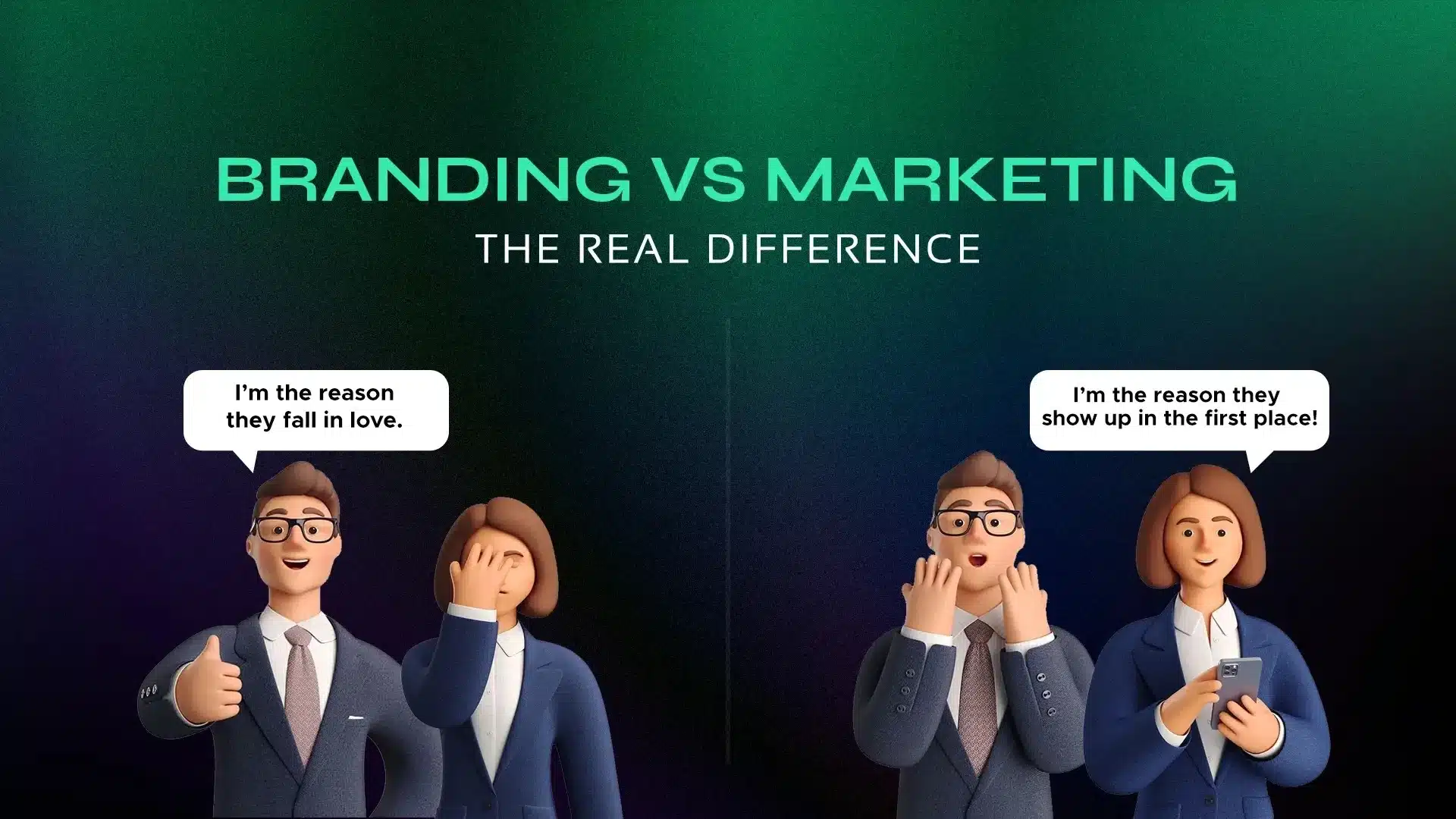Table of Contents
Do you need help understanding the difference between the two concepts, branding and marketing? You’re not alone. Today, many business professionals need help differentiating between the two concepts and which is a part of the other.
Nonetheless, you should know the difference between these two important concepts that can make a difference in the companies. In today’s complex business environment, many startups and sometimes even big organizations are unsure how to define branding and marketing or how to leverage both to build a full-funnel campaign.
Let’s discuss the real difference between Branding vs Marketing
What is Branding?
Branding is the process of creating a unique identity for your business. It enlightens the values, objectives, and goals of your company that you wish to establish. Your brand can be defined as the promise that your organization makes to the buyer regarding what they are likely to experience when dealing with your company.
Some components that fall under branding include logos, brand colors, typography, and even how you communicate. These visual and verbal cues contribute towards the creation of a familiar image that is easily associated with the target audience.
Contrary to what most people think, branding is not just about creating good aesthetics. It is an emotional appeal that fosters familiarity between the audience and the brand, thus, they are loyal. This emotional bond is what forms the basis of first-time buyers to become loyal consumers for a lifetime.
Apple has outdone itself in the tech market and is a prime example of successful branding. Apple’s logo is one of the most recognizable symbols worldwide.
The simple, sleek apple with a bite taken out of it embodies the company’s commitment to design and innovation.
Apple products are known for their minimalistic and elegant design. The aesthetic appeal of devices like the iPhone, iPad, and MacBook is a significant aspect of Apple’s brand identity.
Apple speaks of values like creativity, innovation, and quality always. This is well understood by the customers who view Apple as a company that is technologically advanced and that has a great taste in design.
What is Marketing?
Marketing, in contrast, is the process that you use to sell your product or service. It includes research, planning, and implementation of marketing communication activities that are aimed at reaching out to prospective customers and making them into actual customers.
Marketing strategies can include various tactics such as advertising, social media posts, email newsletters, and search engine optimization. More than half of American consumers (53%) make purchases through social media weekly. All of them seek to ensure that the value proposition of your brand is well transmitted to the targeted audience.
Marketing strategies are subject to change and this depends on factors like customer preferences, economic conditions, competition, and even seasons.
These are targeted at specific groups of audiences, but should always be in harmony with the corporate identity of your business.
Marketing campaigns can be emotional, humorous, or serious and can be in the form of textual, image, video, and meme content. The main objective of marketing is to acquire customers and create demand.
Where branding prepares the ground for customer loyalty, marketing makes sure that your message gets to the intended customer at the right time.
Here’s how Apple uses marketing:
Apple’s advertising strategy turned eyes with its Get a Mac Campaign: This series of TV commercials featured two characters, a cool and casual “Mac” and a stuffy “PC,” highlighting the advantages of using a Mac. The campaign was humorous and effectively communicated the ease of use and reliability of Apple computers.
- Launch Events
Apple always has its product launch events which are always much expected. They are well-planned marketing activities that involve the introduction of new products to the market. These keynotes get a lot of media attention and stir the public thus creating the demand and the sales.
- Digital Marketing:
As part of the digital marketing strategy, Apple uses platforms like Instagram, Twitter, and YouTube to reach a broader audience. Their online ads are visually appealing and focus on the features and benefits of their products.
- Content Marketing
Apple’s website has sections with product descriptions, manuals, and articles that are meant to enlighten the buyers on the new products and innovations. It educates the targeted customers so that they can make informed decisions.
The Relationship Between Branding and Marketing
The relationship between branding and marketing is important because they are two concepts that complement each other. Brand building is also important in marketing as marketing strategies are more efficient when based on a brand. Conversely, consistent marketing helps reinforce your brand identity.
Think of branding as the soil and marketing as the seeds. Without fertile soil, seeds won’t grow into healthy plants. Similarly, without branding, your marketing efforts may not yield the desired results.
Both branding and marketing work together to create a cohesive customer experience. When aligned, they can significantly enhance customer satisfaction and full-funnel campaigns.
What is the difference between marketing and branding?

- How they’re similar: Both marketing and branding efforts aim to elevate the reputation of your company in your target market. Effective branding and marketing rely on consistency to build trust and credibility with your audience. A cohesive brand identity ensures that all marketing efforts—from advertisements and social media posts to customer interactions —reflect the same values, tone, and messaging.
- How they’re different: A brand strategy outlines the identity of your company and provides guidelines on the values, mission, and personality of the company. It aims at designing a unique brand image that would stir the appropriate feeling and perception in the heart of your target market.
Your marketing plan on the other hand defines how you will communicate information about your products or services to your target markets. It includes strategic choices concerning the communication media, the message to be conveyed, and promotions to be launched with the primary objective of making sales and creating leads.
While branding focuses on the long term and attempts to encourage consumers to remain loyal to a specific brand, Marketing is immediate and wants the consumer to act now.
Is Branding More Important Than Marketing?
When it comes to full-funnel campaigns which include all stages of consumers’ journey from the initial stage when they become aware of the brand up to the final stage where they make a purchase, branding, and marketing are crucial.
Branding makes the customer aware of the firm and have confidence in the firm’s products or services hence will consider the firm. The next stage is where the four marketing functions help customers move through the funnel by presenting them with the information and motivation to make a purchase.
Think of it this way: If a company has a good brand image and the customer feels that the company is relevant to them, the company may not reach him/her due to a poor marketing plan. However, if your marketing techniques are producing leads, yet your brand does not appeal to those leads, the likely result will be they may not be regular customers.
Branding and marketing work together to create a holistic approach that can help businesses thrive in competitive markets.
For example, Apple has a powerful brand image based on the principles of innovation, high quality, and the user perspective. This branding lays the groundwork for its marketing messages including new product releases and other marketing initiatives that sustain the company’s dominance in the marketplace.
Thus, while branding lays the foundation for the consumer’s perception and loyalty, successful marketing campaigns are critical for revenues and market share.
Connecting Branding and Marketing
A company looking to boost sales and revenue might rely solely on standalone marketing tactics like SEO keyword research or paid ads. However, to increase awareness, engagement, and conversions, you need strong branding too. If customers don’t feel connected to your brand, they won’t be as loyal, and your conversions will suffer.
Brand development is what results in the creation of long-term and sustainable relationships with customers. Such competition emerges because other organizations within the market are also aiming at offering services that your firm is offering to clients.
It is here that competitors meet the first form of competition not on the product or the price but the brand. Therefore, if your business is not branded, it might be successful but with branding the success will be more noticeable.
Marketing can get you noticed, but branding makes you unforgettable. While marketing campaigns can bring immediate sales, branding ensures that customers keep coming back.
The Role of Digital Marketing in Branding
Digital marketing is a major chunk of contemporary branding efforts since it makes use of the Web as a platform for branding and improving the company’s brand recognition and communication with the target audiences.
Forms of marketing like social media, search engines, and content marketing allow brands to connect with a large global audience.
Organic reach is effective in developing brands since it can help a company spread the word and reach new clients through ads, sponsored content, and similar promotional methods.
Email marketing remains highly effective due to its exceptional effectiveness and ROI. With an average return of $36 for every $1 spent, it not only drives sales but also plays an important role in nurturing customer relationships. By delivering personalized content that aligns with the brand’s values and voice, email marketing helps reinforce brand identity.
Digital marketing makes it easier to establish two-way communication with customers via social media posts, comments, ratings, and emails.
Audiences can leave feedback for the brands, and in return, the brands get an opportunity to engage with the audience and address any issues that the customers may have concerning the brands, hence building brand awareness and trust.
Using visual content, brands can communicate their features, advantages, and personalities; use storytelling to convey the brand story; and use interactive activities to reveal the brand’s character. It assists the brands to be unique in the market as they appeal to consumers who identify with the brands’ principles.
Conclusion
Branding and marketing play distinct yet complementary roles for businesses. The real difference between branding and marketing lies in their unique functions approaches, and respective impacts on a company’s overall success.
Whereas branding defines a company and creates loyalty in customers, marketing sells products and generates income. They are both critical in the current world economy where competition is rife.
It’s important to distinguish Branding vs Marketing so that businesses can employ more efficient strategies for both. Due to advancements in technology and changing trends of the consumers, branding, and marketing need to be aligned to fit the trends.
Thus, businesses should aim at achieving the mid-point between branding and marketing as a way of achieving the best results. Therefore, it can be concluded that a business can develop a long-lasting image when it has a well-defined brand image and the proper marketing promotion.
So every time you make a plan for your company and think about goals, do not limit yourself to the dichotomy of branding and marketing; both are important and should go hand-in-hand.







